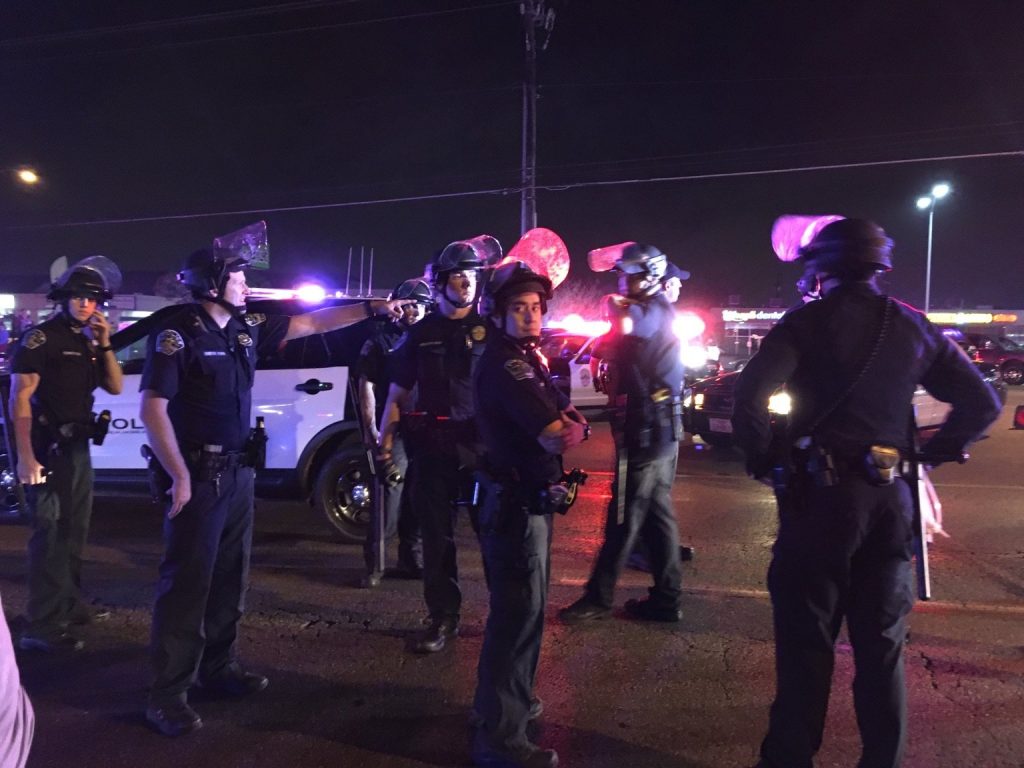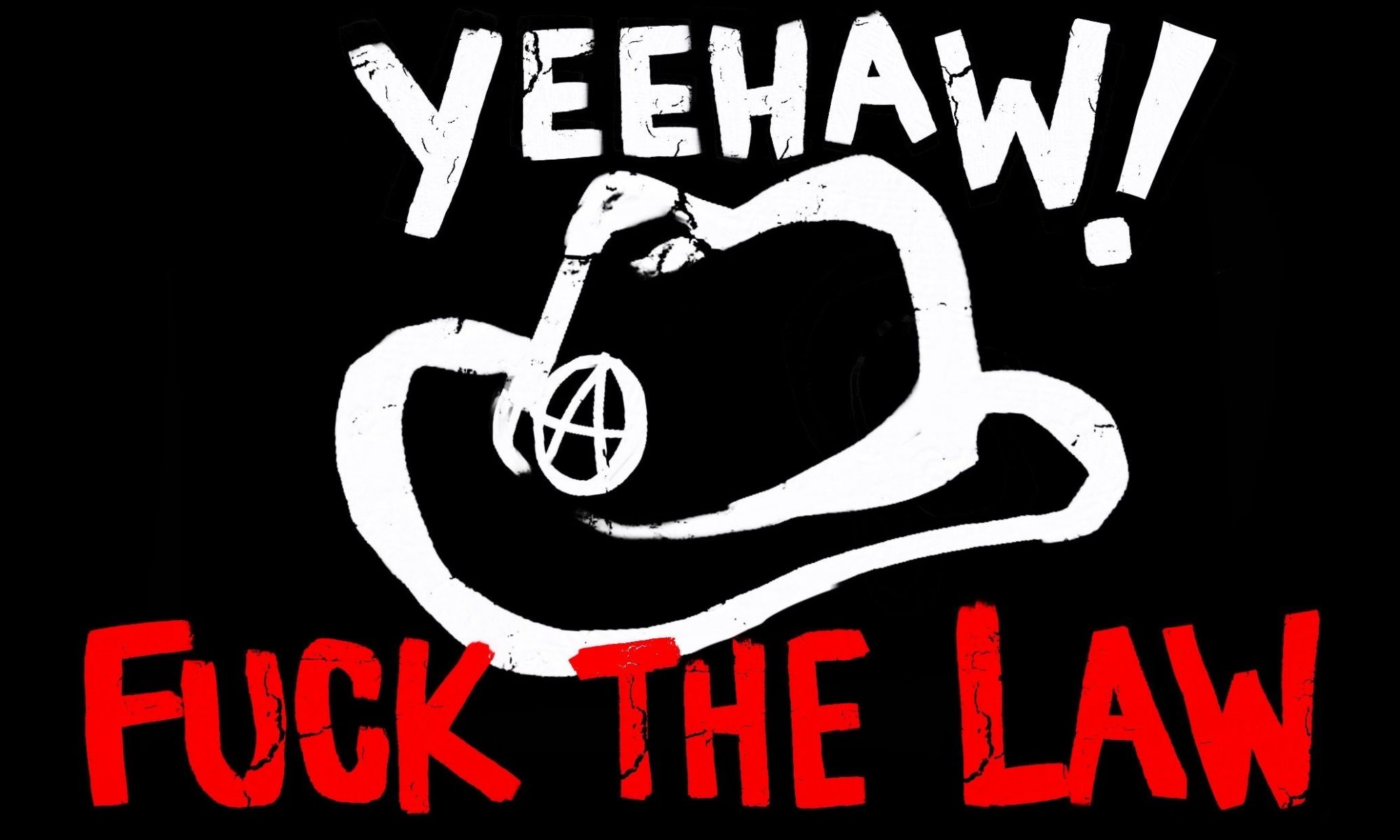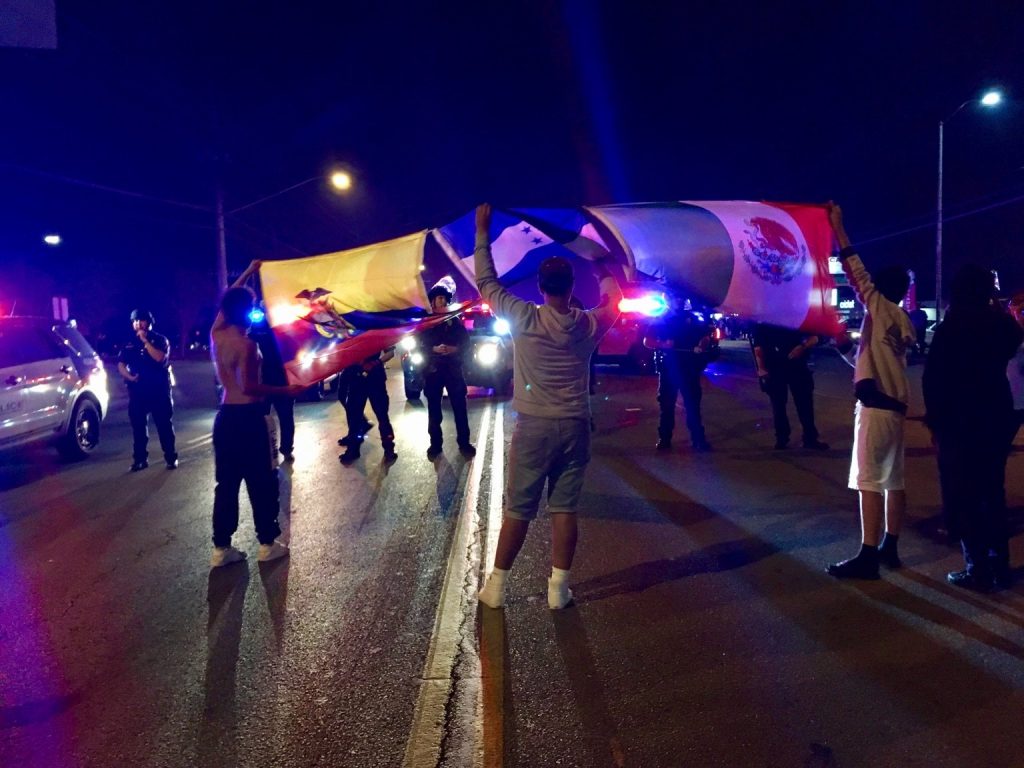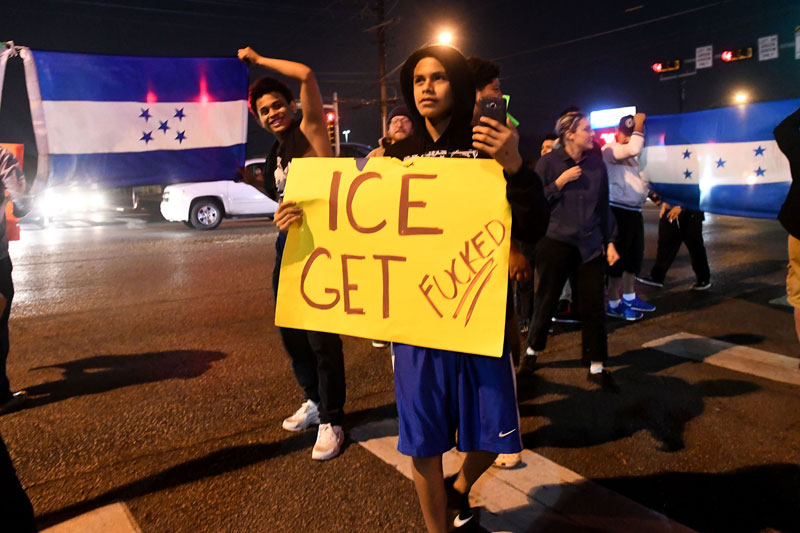Austin Autonomedia: Keeping Austin Criminal
Revolt, of the sort that exceeds the form of permitted street marches and sign-waving rallies, has rarely manifested in Austin’s streets. As such, its occurrences–such as the wave of activity that came with the George Floyd rebellion–deserves attention and uplifting in our historical memory. Four years ago, at the beginning of the Trump’s term, one such revolt manifested in the Rundberg area in North Austin.
In February 2017, the corner of North Lamar and Rundberg exploded in response to a series of ICE raids in the area. Starting on February 10th, the area would see two night of sustained, riotous protest, with fireworks launched, a police car burned, and rumors of at least one store looted (or attempts made to do so). While the burst of energy was short-lived, it left a mark on all who participated in it, and simultaneously pointed at the fractures and failures of Austin’s various community policing initiatives. Many of the fractures made visible here, namely the antagonism to the law and its enforcers, would be visible in the rebellions of the summer of 2020 as well. One might read the Rundberg rebellion as a sort of prelude to the 2020 uprising, in that it was a manifestation of confrontational, militant street actions which came into antagonism with the law, property, & notions of political respectability, while exceeding in its inception the control of non-profit activists and politicians seeking to regulate movements.
Looking back 4 years later, we want to ensure the revolt remains in our collective memory. The Rundberg area, and North Austin writ large, will undoubtedly remain an important locus of struggle in the future. It is the home to many of Austin’s most exploited and marginalized communities, and thus the target of efforts that range from gentrification & redevelopment to community policing & surveillance.
Below, are two articles which recount aspects of the Rundberg Rebellion–one dedicated to it, and the other an excerpt of a larger year in review piece published by the Autonomous Student Network in 2018. We’ve supplemented the text with videos and pictures. While the text of both pieces remains unchanged, the pictures and videos embedded in the “Rundberg Revolution” piece were curated by us. After the two articles is an interview with a member of Black Rose Austin about the resistance to ICE raids in Austin.
From “Rundberg Revolution” published in the March 2017 edition of the Challenger Street Newspaper
On Thursday, February 9th, Immigration and Customs Enforcement (ICE) raids surged in central Texas detaining more than 50 people. That morning several people had been picked up and ICE agents visited schools and workplaces. Detainees were held at the JJ Pickle Federal Building downtown. There were two gatherings at the federal building. A vigil was held the evening of the 9th and on the morning of the 10th, a small demonstration. On the tenth, a video circulated of a man kneeling, handcuffed, in front of a Whataburger at the corner near Lamar and Rundberg in far North Austin. Friday evening, a member of a local copwatch organization called for a demonstration on the corner of Lamar and Rundberg, creating the space for some of the highest intensity struggle in Austin, TX in a decade.
The demonstrations the weekend following the ICE raids revealed a hostility to the law and the new regime that is unlikely to disappear. Activists and city government have bemoaned the interference of the raids, as these shake up already present tensions in the city and frustrate the efforts made by local law enforcement to build trust with some of the neighborhood’s inhabitants and make the area more hospitable to developers.
Local and state immigration politics have fostered this moment, leveraging splits within the state. For many years, immigrant’s rights organizations, NGOs, and churches struggled unsuccessfully to pressure former Sheriff Greg Hamilton to discontinue their relationship with ICE, holding detainees in the county jail for transfer to detention centers and eventual deportation. When Sally Hernandez took the Sheriff’s office in January of 2017, the policy changed. The jail would only hold people charged with “very serious crimes”. In fact, after the policy change, dozens of people were released.
The Austin Police Department never developed a policy of non-cooperation, despite pressure. Art Acevedo, former chief of police wrote an article criticizing the cooperation program, Secure Communities, for threatening the city’s community policing model. This criticism did not stop Acevedo from interviewing to become the head of ICE in 2014. APD officers were still allowed to ask for immigration status but supposedly would not make an arrest on that basis alone.
Though immigrants rights groups point out that city and county resources are still being used to aid ICE, Travis County and Austin became known as Sanctuary communities. Hernandez in particular has become a target of ire. Governor Greg Abbot has personally threatened her position and state legislation was quickly introduced to force cooperation of local law enforcement and ICE. Hundreds of people signed up at a Senate committee meeting to speak against Senate Bill 4 and many stayed through the day and into the night. Regardless, it was passed out of committee and will be up for a vote and consideration by the Texas House of Representatives in the coming months. When the raids began on Thursday, February 9th, there was a sense that Travis County was being punished for the actions of Hernandez.

The raids have already had a poor effect on public perception of APD. The department has made multiple public statements declaring that they are not participating in the arrests, but served as security forces for ICE agents, aiding in the smooth operation of the raids. A news story emerged on February 9th of an ICE agent being sent to the hospital after the family resisted a person being detained. In follow up articles, the family denies that there was a conflict. An APD officer who was called in said the family “got out of hand.” The two women ended up being arrested on prior warrants by APD. In a separate incident a man was charged with assaulting an ICE officer during his detention.
Rundberg is home to a poor, diverse, and dense population. In a city study of the area in 2012, it was recorded that 95% of the children enrolled in school were “economically disadvantaged”. 64% spoke languages other than English and a large percentage of those were classified as refugees. Its major thoroughfares have sprawling strip malls and parking lots, surrounded by apartments and rented houses. In 2008, while only 5.5% of properties have a multifamily use, 60% of the population lived in multifamily developments. Also noted in the city survey: Rundberg zip codes had the among the lowest levels of trust in police.
Google the intersection “Lamar and Rundberg” before February 10th 2017 and most of what you will find is news about drugs, prostitution, and other crime as well as efforts to “clean up” the neighborhood. News stories are shock pieces are about SWAT raids, drug busts, and hotel stakeouts; in addition to these harder forms of policing the area has become known as the staging ground for a “softer” police project: Restore Rundberg.
Restore Rundberg’s community policing program put the police front and center of an effort to make the area ready for gentrification and development by driving down the crime rate. In addition to block walking and hosting public forums, the police focused on several “hot spots” in the neighborhood and coordinated with the city code department to cite run-down properties and haul away illegally parked vehicles. This is Austin’s version of broken windows policing, a nationally notorious policy known for preparing neighborhoods for displacement and gentrification.
On January 22nd of 2016, Monica Loera became the first known trans woman to be killed in the US that year, an incident which drew further attention as she was callously misgendered in the media. Loera, also a sex worker, was shot in front of her Rundberg home, likely by a john. In the aftermath, many liberal activists and city politicians mourned her death, never mentioning that she was exactly the type of person that the Restore Rundberg project plans to remove from the area. In 2016 funding for the Department of Justice funded Restore Rundberg Project lapsed and it is unclear if the job is finished or what will take its place.
As the weekend progressed more and more reports of raids came in. Many, many unconfirmed rumors circulated and suspision clouded every police car. People organized into community defense committees by the group ICE Out of Austin tried to confirm and respond to reports of raids, but often were chasing ghosts or arrived late to pick up the pieces and console family members. The committees had prepared for house raids and the arrests seemed to play out on the sides of highways and roads, workplaces, and nearby schools. The clearest documentation came Friday, Facebook Live video of a man on his knees by his truck outside the Whataburger near Rundberg and Lamar pleading with Immigration officials. Hours later, a single member of the Peaceful Streets Project arrived at the intersection with extra signs and numbers grew dramatically over the evening.
What started out as five or so people gathered on the corner of Rundberg and Lamar grew over the course of a few hours to a lively crowd of 200 people, almost entirely Latino/a families. The spirit is festive; nearly everyone is smiling, cheering. The sense was that “Rundberg’s time has finally come.” The demonstration lines both Lamar and Rundberg going about half a block down each street with the mass milling on the corner. People hold signs, flags (Mexico, Honduras, Ecuador, Palestine, and a few others), children, and phones. The intersection filled with cars and trucks driving slow, revving engines, and taking pictures—some are circling the block to do it all over again. The sound of car horns is unrelenting.
The gatherings continue the next night and the social peace with APD is broken. Roads are blocked, orders are disobeyed, bottles are thrown at officers. Riot police are everywhere, a helicopter circles above, but all are contained by the tension of community policing. Their job is to maintain an unjust social order, but with a light enough touch to prevent a rebellion and to make sure that their investment in Rundberg is intact.
https://www.youtube.com/watch?v=ZKhHP1Kc8zU
The miltancy spread into workplaces and schools. Teenagers staged highschool walkouts daily and the week culminated in “A Day Without Immigrants” on February 16th. Many businesses closed and others were forced to close. An estimated 20,000 students did not show up for classes—a quarter of kids enrolled in the Austin Independent School District. Students in suburban high schools marched on highways 290 and 71, some saying they were headed into the inner city. Eventually many were corralled by APD, Sheriffs and administrators and forced to go back to class. Several administrators made personal appeals to students to think of the funding the school would lose without them sitting in their seats.
In the days since, reports of raids have slowed and many parties are assessing the events, we can expect the raids to occur again, pulsing and continuing to play on tensions in the neighborhoods.
From “Agitate, Subvert Negate! Playful Reflections from the Ruins of Empire” by the Autonomous Student Network at UT Austin.
Published January 11, 2018.
Perhaps the most remarkable show of militant self-activity, yet one of the least discussed, is the Rundberg Rebellion of February. In response to the ICE crackdown on undocumented immigrants and recent raids, a spontaneous mass protest developed over multiple nights among the Latinx community at the intersection of North Lamar and Rundberg. This would come to be unlike any protest held by either liberal activists or the traditional Left. Dozens to hundreds of people filled the intersection, waving the flags of various countries. Many ran laps around the intersection, jubilantly dancing, clapping, and chanting things like “No rules, No ICE, let’s fuck this shit up!” As people took over the street, many stopped their cars and joined the action. Rather than another overdone street rally, the revolt took on a jubilant and defiant nature as an entire community manifested its social life in the intersection.

The police came out in full force and riot gear, terrified of the true potential of the insurrection that was developing, but they could do little but watch. Their arrival produced confrontation, with the militant youth launching water bottles and whatever debris they could find. While many Austin revolutionaries had arrived to participate alongside the community, they were not the first to mask up—it was the youth who donned masks and initiated confrontations, contrary to the assertions of many activists who have claimed that masking (and even militancy) are alien to Latinx and immigrant communities. These young insurrectionaries even defended the other militants against the anger of others who wanted the protest to retain a more peaceful, controlled nature. Though massively outgunned, the revolt did not need to defeat the police militarily because it had already won at a social level. The consistency, the social connections and community produced in that space—which one comrade described as “reclaimed…totally autonomous from the State”—ensured that the State could not penetrate or reclaim the territory until the people dispersed of their own volition.
Fireworks lit up the night and the celebratory crowd—with some reports even saying that a building and a cop car were burned over the weekend. Music blared through the night and produced a full-fledged dance party in the street. In an intersection ringed by riot cops people danced and sang along to “Fuck Tha Police.” Despite attempts by some to turn this into a moment to proselytize about their revolutionary program, the insurrectionaries maintained a jubilant and joyful revolt. They learned their politics not through lectures or books but by through experimentation and actualizing their capacity to hold space, through the rhythms of music and the movement of their bodies. Eventually though, this moment came to a close as over the next week the energy dissipated back into the community, the streets were not as filled, and the police seized upon certain community “representatives” to control the event while claiming that the confrontations were the result of “outside agitators.” We of course know that this is a lie—a racist lie that obscures the militant desires and self-activity of the exploited and excluded against the white supremacist State—and we know that the insurrection lives on in the community, in organizational efforts like the Instituto Tejano, and that it can always reactivate.
ICE Raids & Resistance: An Interview with Black Rose/Rosa Negra – Austin
Published by A World Without Police in April 2017
In February, Austin, TX was rocked by a series of protests over ICE raids that resulted in over 50 immigrants being detained. Despite backlash from school administration, students played an active role in the mobilizations as they staged walk outs, highway take overs and street protests. The oppressive role of police goes beyone killing black and brown people on the street. In this interview AWWP explores the broader function the police and court system serve in their collaboration with ICE in attacking immigrant communities.
Luis is a member of BRRN in Austin and he joins us to give insight into the immigration struggle there. He’s also involved with ICE Out, an organization that seeks to end the Priority Enforcement Program and all conflation of local law enforcement with Immigration in Austin. Look out for updates as immigration struggles continues to unfold across the country.
Intro music clip: Chingo Bling – Like This and Like That
Got a something you need to publish? Send it to us! We take all kinds of radical/revolutionary content, with a special affinity for anarchist/autonomous movements and crews. We specialize in research and strategic intelligence that can inform direct action, but we’ll take art, opinion pieces, and other stuff too! Submit content to austinautonomedia [@] autistici [dot] org.



